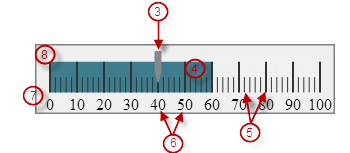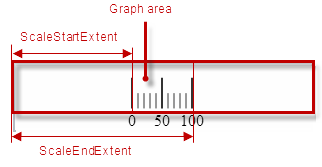This topic provides conceptual information about the igLinearGauge™ control including its main features, minimum requirements, and user functionality.
This topic contains the following sections:
The igLinearGauge control is an Ignite UI for jQuery control which allows for visualizing data in the form of a linear gauge. It provides a simple and concise view of a primary value compared against a scale and one or more comparative ranges.

The igLinearGauge control provides you with the ability to create attractive data presentations and has multiple application usage scenarios.
The features of igLinearGauge include configurable orientation and direction, configurable visual elements and tooltips, and more. The control has also a built-in support for animated transitions.
The following table summarizes the main features of the igLinearGauge control.
| Feature | Description |
|---|---|
| Configurable orientation and direction | The igLinearGauge control exposes an API for setting the state of its scale’s orientation and direction, so that the look of the gauge can be largely customized. (For details, see the Configuring the Orientation and Direction (igLinearGauge) topic.) |
| Configurable visual elements | Each of the visual elements of the linear gauge can be configured in several aspects. (For details, see Configurable Visual Elements of igLinearGauge and Related Properties.) |
| Animated transitions | The igLinearGauge control provides built-in support for animation by its transitionDuration property. The animation effect occurs on loading the control as well as when the value of any of its properties is changed. By default, animated transitions are disabled. Providing a value in milliseconds for the transitionDuration property of the control determines the timeframe for swiping the control into view by smoothly visualizing all of its visual elements through a slide effect (from bottom-left to top-right). Setting the value to 0 disables the animated transition. For a sample, demonstrating the animation transition effect, see the Animated Transitions sample. |
| Support for tooltips | The built-in tooltips of the igLinearGauge control show the values used to create the needle, or the values, corresponding to the different ranges respectively. They are initially styled in accordance with the default look of the control, but their look can be customized by templates. By default, tooltips are disabled. (For details, see Configuring the Tooltips (igLinearGauge)) |
The user-visible area of the igLinearGauge control is logically divided into the following areas: Title area, Reserved area, and Graph area.
| Horizontal orientation | Vertical orientation |
|---|---|
 |
 |
Each of them serves different purpose related to some of the visual elements of the igLinearGauge control.
The main purpose of the Reserved area is to provide enough space for the numbering labels of the scale at any orientation – horizontal or vertical (The Reserved area automatically re-sizes when the orientation changes in order to accommodate the specific space requirements for displaying the numbering labels in each of the orientations: in horizontal orientation, the area has to fit the labels’ height and in vertical orientation – their maximum width.) This doesn’t mean that you must necessarily place the numbering labels in the Reserved area: actually, you can position the label row across-the-scale anywhere within the Graph area. However, even if you place the label row outside Reserved area, this will have no bearing on the spread and location of the Reserved area itself – it remains where it is, automatically defined through the height/width (depending on the orientation) of the numbering labels.
Another aspect in which the Reserved area is significant is the fact that its inner edge specifies the beginning edge of the Graph area in the across-the-scale dimension. This is important, because this edge serves as a reference mark for the extent-related properties that position some visual elements across the scale. (Positive values for these properties – the most common case – position the visual elements inside the Graph area and negative values – inside the Reserved area.)
Spread of the Graph area:
The igLinearGauge control features the following visual elements (See the picture below):
Needle (3) – This is the primary indicator displayed by the control and is visualized as a hovering bar element, which moves along the gauge's scale; its current position along the scale indicates the gauge's value.
Comparative range(s) (4) – The ranges are visual elements that highlight a specified range of values on a scale. Their purpose is to visually communicate the qualitative state of the performance bar measure, illustrating at the same times the degree to which it resides within that state.

There are several specific aspects in which each element can be configured.
The following table provides an overview of the configurable aspects of the visual elements of the igLinearGauge control. Further details about the configurable aspects with illustrations and the properties that configure them are available, for each visual element, in the blocks that follow the table:
| Visual element | Main configurable aspects |
|---|---|
| Scale |
|
| Needle |
|
| Comparative ranges |
|
| Background |
|
| Tooltips |
|
The following pictures illustrate the scale-related extents, listed in the table below.
| Extent positioning the scale within the Graph area | Extents configuring the position of the labels |
|---|---|
 |
 |
| Extents configuring the major tick marks along the scale | Extents configuring the major tick marks across the scale |
|---|---|
 |
 |
Extents configuring the minor tick marks across the scale

The following table maps the configurable aspects related to the scale of the linear gauge to the igLinearGauge properties that manage them.
| Configurable aspects | Property | Default value | |||
|---|---|---|---|---|---|
| Position | scaleStartExtent | 0.05 | |||
| scaleEndExtent | 0.95 | ||||
| Range and Values | Max value | minimumValue | 0 | ||
| Min value | maximumValue | 100 | |||
| Tick marks | Major tick marks | Position (within the scale), spacing, and length | interval | Not set | |
| ticksPostInitial | 0 | ||||
| ticksPreTerminal | 0 | ||||
| tickStartExtent | 0.02 | ||||
| tickEndExtent | 0.2 | ||||
| Look-and-feel | Color | tickBrush | Defined in the default theme | ||
| Width | tickStrokeThickness | 2.0 | |||
| Minor tick marks | Number (between two adjacent major tick marks) | minorTickCount | 3.0 | ||
| Position | minorTickStartExtent | 0.06 | |||
| minorTickEndExtent | 0.2 | ||||
| Look-and-feel | Color | minorTickBrush | Defined in the default theme | ||
| Width | minorTickStrokeThickness | 1.0 | |||
| Labels | Position and spacing | labelExtent | 0 | ||
| labelInterval | Not set | ||||
| labelsPostInitial | 0 | ||||
| labelsPreTerminal | 0 | ||||
| Number format | labelFormat | Not set | |||
| Look-and-feel | Color | fontBrush | Defined in the default theme | ||
The following picture illustrates the needle-related extents, listed in the table below.

The following table maps the basic configurable aspects related to the needle of the linear gauge to the igLinearGauge properties that manage them.
| Configurable aspects | Property | Default value | |
|---|---|---|---|
| Value indicated | value | Not set | |
| Breadth | needleBreadth | 10.0 | |
| Look-and-feel | Fill color | needleBrush | Defined in the default theme |
| Border color | needleOutline | Defined in the default theme | |
| Border thickness | needleStrokeThickness | 1.0 | |
| Shape | needleShape | Needle | |
The following picture illustrates the comparative-ranges-related extents, listed in the table below.

The following table maps the configurable aspects related to the comparative ranges of the linear gauge to the igLinearGauge properties that manage them.
| Configurable aspects | Property | Default value | |
|---|---|---|---|
| Number (of ranges in the gauge) | ranges | Not set | |
| Length, width, and position | startValue | Not set | |
| endValue | Not set | ||
| innerStartExtent | Not set | ||
| innerEndExtent | Not set | ||
| outerStartExtent | Not set | ||
| outerEndExtent | Not set | ||
| Look-and-feel | Fill color | brush | Defined in the default theme |
| Border color | outline | Defined in the default theme | |
| Border thickness | strokeThickness | 1.0 | |
| Tooltip | rangeToolTip | The start and end values of the range separated by a hyphen (-). | |
The following picture illustrates the background-related extents, listed in the table below.

The following table maps the configurable aspects related to the background of the linear gauge to the igLinearGauge properties that manage them.
| Configurable aspects | Property | Default value | |
|---|---|---|---|
| Spread and position (across the scale) | backingInnerExtent | 0 | |
| backingOuterExtent | 1.0 | ||
| Look-and-feel | Color | backingBrush | Defined in the default theme |
| Border color | backingOutline | Defined in the default theme | |
| Border thickness | backingStrokeThickness | 2.0 | |
The following table maps the configurable aspects of the igLinearGauge control related to tooltips to the properties that manage them.
| Configurable aspect | Details | Properties / Events | Default value | |
|---|---|---|---|---|
| Visibility | You can enable/disable tooltips for the igLinearGauge control. | showToolTip | False | |
| Delay | The timeout before the tooltip appears upon the visual element at mouse hovering is configurable in milliseconds. | showToolTipTimeout | 500 | |
| Value | You can provide a custom value for the respective tooltip property. | Needle | needleToolTip | Depends on whether needleName has been initialized (see Configuring a Custom Tooltip for the Needle) |
| Comparative Range(s) | rangeToolTip | The start and end values of the range separated by a hyphen. | ||
By default, the igLinearGauge control is oriented horizontally. It displays with a scale starting at 0 and ending at 100. The major tick marks of the control are located at an interval of 10 and the count of minor tick marks between each pair of major tick marks is 3. There is no title/subtitle displayed, the background color is a variety of light grey. The border is 2 pixels thick colored in dark grey. No needle or ranges are displayed. Animated transitions are disabled.
The following picture demonstrates an igLinearGauge displayed with default settings.

The igLinearGauge control is a jQuery UI widget and, therefore, depends on the jQuery and jQuery UI libraries. References to these resources are needed nevertheless, in spite of the use of pure jQuery or Ignite UI for MVC. The Infragistics.Web.Mvc assembly is required when the control is used in the context of ASP.NET MVC.
In order for the linear gauge to display the needle, the value property has to be set.
For the full requirements listing, refer to the Adding igLinearGauge topic.
The following topics provide additional information related to this topic.
Adding igLinearGauge: This topic explains how to add the igLinearGauge control to an Ignite UI for jQuery application.
Configuring igLinearGauge: This is a group of topics explaining how to configure the various aspects of the igLinearGauge control including its orientation and direction and visual elements.
jQuery and MVC API Links (igLinearGauge): This topic provides reference information about the key classes and properties related to the igLinearGauge control.
Known Issues and Limitations (igLinearGauge): This topic provides information about the known issues and limitations of the igLinearGauge control.
The following samples provide additional information related to this topic.
Basic Configuration: This sample demonstrates a simple configuration of the igLinearGauge control.
Animated Transitions: This sample demonstrates animated transitions between different sets of settings in the igLinearGauge control.
View on GitHub